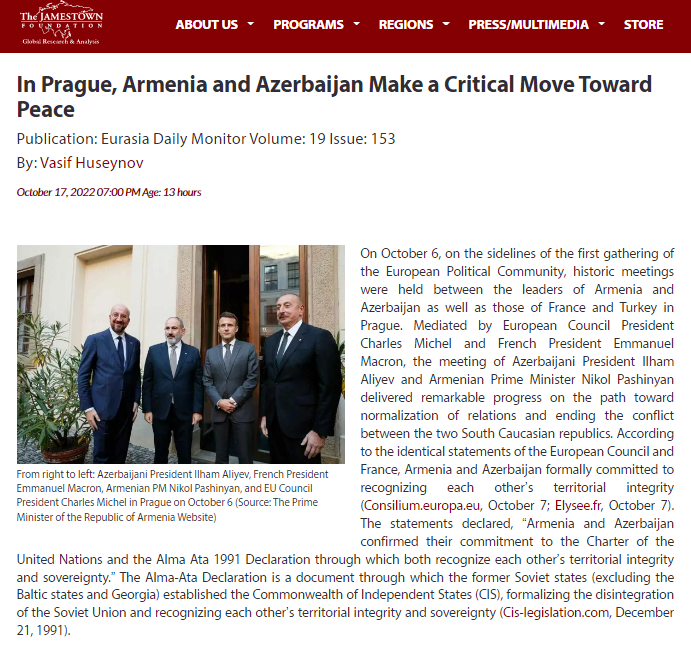On October 6, on the sidelines of the first gathering of the European Political Community, historic meetings were held between the leaders of Armenia and Azerbaijan as well as those of France and Turkey in Prague. Mediated by European Council President Charles Michel and French President Emmanuel Macron, the meeting of Azerbaijani President Ilham Aliyev and Armenian Prime Minister Nikol Pashinyan delivered remarkable progress on the path toward normalization of relations and ending the conflict between the two South Caucasian republics. According to the identical statements of the European Council and France, Armenia and Azerbaijan formally committed to recognizing each other’s territorial integrity (Consilium.europa.eu, October 7; Elysee.fr, October 7). The statements declared, “Armenia and Azerbaijan confirmed their commitment to the Charter of the United Nations and the Alma Ata 1991 Declaration through which both recognize each other’s territorial integrity and sovereignty.” The Alma-Ata Declaration is a document through which the former Soviet states (excluding the Baltic states and Georgia) established the Commonwealth of Independent States (CIS), formalizing the disintegration of the Soviet Union and recognizing each other’s territorial integrity and sovereignty (Cis-legislation.com, December 21, 1991).
This peace summit came on the heels of recent escalation along the Armenian-Azerbaijani state border, which resulted in Azerbaijan taking control of some disputed areas that Armenia had claimed as part of its internationally recognized territory (See EDM, September 20, 28, October 4). The agreement on the mutual recognition of territorial integrity, thus, opens a window of opportunity to accelerate the delimitation and demarcation process and eliminate the territorial disputes that have fueled these armed confrontations. This issue is also reflected in the aforementioned statements, according to which Yerevan and Baku confirmed that their mutual recognition of territorial integrity and sovereignty “would be a basis for the work of the border delimitation commissions and that the next meeting of the border commissions would take place in Brussels by the end of October” (Consilium.europa.eu, October 7; Elysee.fr, October 7).
The border commission, which was established according to the results of the European Union–mediated summit on May 22 and has had two meetings since, was previously supposed to meet in November 2022 per the agreement at the August 31 summit (See EDM, May 31, September 20). Nevertheless, the convening of the next meeting is likely to coincide with the deployment of a civilian EU mission along the Armenian border with Azerbaijan, which is another key outcome of the Prague summit. The EU mission will be deployed in Armenian territory along the Azerbaijani border in October 2022 for a maximum of two months, and Azerbaijan has “agreed to cooperate with this mission as far as it is concerned” (Consilium.europa.eu, October 7; Elysee.fr, October 7). At the time of writing, most questions regarding the overall nature of this mission (its core goals, capacity, type of personnel, etc.) remain unclear. The EU statement reported that “the aim of this mission is to build confidence and, through its reports, to contribute to the border commissions” (Consilium.europa.eu, October 7). According to the Lithuanian Ministry of Foreign Affairs, the proposal for the EU mission on the ground was first made by the foreign ministers of Lithuania, Austria and Moldova, who visited the South Caucasus in June 2021 (Twitter.com/LithuaniaMFA, October 7).
Another crucial event took place on the sidelines of the Prague summit—namely, the first meeting between Pashinyan and Turkish President Recep Tayyip Erdogan. Reportedly, the two leaders discussed further steps for the normalization of Turkish-Armenian relations, particularly referring to the opening of a land border for citizens of third countries and the implementation of direct air cargo transportation between Armenia and Turkey (Armradio.com, October 6). Reaffirming his government’s support in the Armenian-Azerbaijani peace process, the Turkish president stated at a press conference that his country will normalize relations, and its land border, airspace and railway lines will be reopened with Armenia as soon as Yerevan signs a peace agreement with Baku (News.am, October 7).
All these developments create a unique opportunity for Armenia and Azerbaijan to proceed with the peace treaty and other initiatives that would be critical to generating lasting peace and stability in the region. Aliyev, in an interview following the Prague summit, stated that, if agreed, the working groups of the two countries would start drafting the text of the peace deal, in hopes that the two sides will sign the treaty by the end of this year (Azertag, October 6).
However, a number of challenges could destabilize the situation and seriously undermine these efforts. One major uncertainty is related to the goals and objectives of the Armenian government. According to Azerbaijani experts, Armenia may try to discard responsibility for recognizing Karabakh as formally part of Azerbaijan even after the Prague agreements by arguing that “constitutional documents” were adopted in Yerevan before the Alma-Ata Declaration and those stated the will of the Armenians in Karabakh to be united with the Republic of Armenia (Facebook.com/aircenteraz, October 10).
This would basically mean the persistence of former narratives promulgated by the Armenian leaders, who argued that “Nagorno-Karabakh” declared independence before the Alma-Ata Declaration. For example, a document dated 2016. and still available on the website of the Armenian Ministry of Foreign Affairs. argues that “on December 10, 1991, the referendum for independence of the Nagorno-Karabakh Republic was held in Nagorno-Karabakh in the presence of international observers [the referendum for Azerbaijani independence was not held until December 15]. On December 21, 1991, the leaders of 11 Soviet Republics dissolved the Soviet Union by the Alma-Ata Declaration. Thus, at the moment of the dissolution of the Soviet Union, two independent and legally equal subjects were formed on the territory of Soviet Azerbaijan—the Nagorno-Karabakh Republic and the Republic of Azerbaijan” (Mfa.am, 2016). Indeed, the present peace efforts will fail to deliver any tangible results if the Armenian government continues to manipulate these narratives and refuses to recognize Karabakh as part of Azerbaijan.
https://jamestown.org/program/in-prague-armenia-and-azerbaijan-make-a-critical-move-toward-peace/








